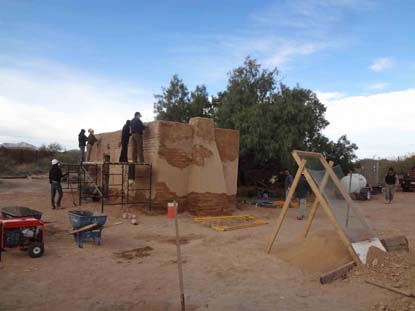|
You are viewing ARCHIVED content published online before January 20, 2025.
Please note that this content is NOT UPDATED, and links may not work. For current information,
visit https://www.nps.gov/aboutus/news/index.htm.

AJO, AZ - This year participants came from a diverse background including the Tohono O'odham Nation, Iran, Spain, Chile, and over 40 students from 10 different universities to work on four projects to preserve historic structures at Organ Pipe. Field schools bring together professional experts, students, volunteers and resource managers. The experience at Organ Pipe provided hands-on training in documentation of vernacular structures and repair and reconstruction in wooden and earthen materials. For the first time there was a classroom component of the field school, which was very successful. With support of International Sonoran Desert Alliance and use of beautiful facility at the Curley School for evening presentations participants were introduced to the concepts of preservation as well as projects from throughout the Southwest and around the world. The field school's ambitious agenda included condition assessment at seven sites with rehabilitation completed at four locations. At Milton Mine, Lost Cabin Mine, and Alamo Canyon Ranch condition assessment and scale drawing documented the sites. With the information derived from this work the monument will have a basis to determine future rehabilitation. At Bonita Well Ranch the ramada was reconstructed. New posts were installed and the structure reassembled from native materials from Civano (mesquite Y-posts), ORPI (ocotillo), and Tohono O'odham Nation (saguaro ribs). A three year foundation sill replacement project was completed at Bates Well Ranch. The new foundation sills were attached to the framing with sill plates to maintain the structural integrity. On the interior, historic Homosote Wallboard was removed intact which exposed termite damaged. The damaged framing was either repaired or replaced and additional bracing installed where needed. In addition, documentation and drawings of the kitchen cabinets were completed for a future project. Dos Lomitas Ranch benefited from the work with new window and door screens being constructed and installed which will keep bats from roosting inside the building. The roof was cleaned and prepped with a new elastomeric coating to prevent rain and moisture from getting in. Gachado challenged the school participants with creating an adobe mud mixture that will hold up to the monsoon rains. They tested six different mixtures of adobe mud cactus mucilage (nopal), which includes prickly pear cactus juice. The students removed all areas of loose plaster, prepped walls, and applied test patches which will be evaluated in the future. Drawings to document interior conditions were made which will help assess the need for the continuing cyclic work. |
Last updated: February 24, 2015
